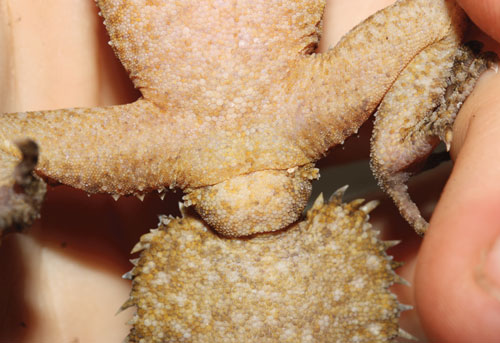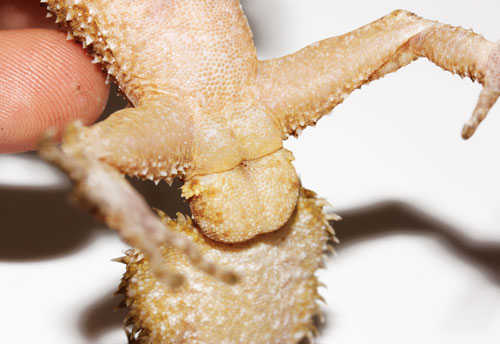Breeding tips for the broad leaf tailed gecko.
Breeding broad-leaf-tailed geckos (Phyllurus platurus) is easy as long as a few things are done. First, make sure you have a male and a female. Males have a visible hemipenal bulge at the vent region, but females don't. Geckos should be at least 18 months old and weigh at least 18 grams before breeding.
A pair of adults can be kept in a cage measuring approximately 20 inches long, 20 inches wide and 20 inches tall. I prefer to house my broad-leaf-tailed geckos in pairs because it helps me keep track of lineage and specific information regarding each pairing. Other breeders have bred these geckos in small groups with no problems, but it is important to house only one male per cage. In the wild these geckos are seen often alone at night, but several might share the same crevice during the day..
A Cool-Down Is Key
The key factor to breeding broad-leaf-tailed geckos is to provide a cool-down for two to three months. I prepare my geckos for cooling around Thanksgiving. The first thing I do is let the broad-leaf-tailed geckos clear their stomachs. For a week I do not feed them. During this time I keep the temperature stable at 72 to 78 degrees Fahrenheit during the day and in the low 70s or high 60s at night. I do not drop the temperatures until they have had the chance to digest the food left in their intestines. When the week is up, the geckos’ stomachs will be clear of food, and I can cool them without worrying that any remaining food in their stomachs might rot and end up being fatal.
Temperature drops should be done gradually. I drop daytime temperatures by 2 to 3 degrees a day. For the next three months, I keep temperatures between 50 and 60 degrees. I try to keep broad-leaf-tailed geckos cooler than 60 degrees, but I have had temps increase to the mid-60s, and my geckos still bred without issues.
Basically, cooler is better. In the wild broad-leaf-tailed geckos might experience temperatures near freezing, so I sometimes drop temps to the high 40s for a night. These geckos are still quite active even at 50 degrees, and I have even witnessed mine mate when the cage was at 54 degrees.
During the cool-down period I mist the cage every night to keep up humidity and provide broad-leaf-tailed geckos with water to drink. Right after the misting, humidity is near 100 percent, but between mistings it drops to between 55 and 60 percent.
Broad-leaf-tailed geckos will not eat during the cool-down period, so keep an eye on them to make sure they are not losing weight. My geckos actually have the same weight going into cooling as they have coming out. If a gecko loses more than a few grams, I remove it from the cooling cycle. These geckos store fat in their tails, so use the tail as a health indicator. Any gecko showing signs of sickness must be taken out of cooling and brought back up in weight.
Cooling is complete after two to three months. After this period I start raising the temperature back up over a week to normal, 72 to 78 degrees during the day, and offer food.

Photo by Derek Dunlop
Female broad-leaf-tailed geckos lack a hemipenal bulge
Watch for Eggs
After the broad-leaf-tailed geckos are feeding normally and look healthy, you can introduce the geckos if they were not already cooled together.
Witnessing a mating happens infrequently, so don't worry if you don't see anything. After one to two months, you should start to see eggs inside the female. They are very easy to see through the semitransparent belly of these geckos.
Two to three months after introductions, expect to find eggs in the enclosure. Female broad-leaf-tailed geckos usually lay two eggs per clutch. A female gecko appears thinner after laying her eggs, and you will no longer see two big white ovals near her abdomen.
Finding broad-leaf-tailed gecko eggs is easy. A female gecko needs damp peat moss or coco-fiber around 3 to 4 inches deep. Substrate should be damp enough to hold together if you clump it — but no wetter. A female digs what looks like a bird’s nest right in the substrate, and she lays the eggs in the middle. She does not need an egg-laying box if she has the right substrate. Then she backfills her nest and guards the mound usually by sitting on it. My females always lay during the day. I can usually tell when eggs have been laid just because the female is on the substrate rather than in her usual hiding place off the ground.
I remove eggs as soon as I see the female has laid them. Even after removing the eggs, my females often stay close to the mound for a number of hours.
I incubate broad-leaf-tailed gecko eggs in a 1-to-1 mixture of perlite to water by weight. Although I have heard temperature plays a roll in sex determination, I do not know for certain. I am currently experimenting with the concept. I incubate eggs at 70 to 72 degrees in hopes of some females. I assume a higher temperature would yield more males, but I do not know for certain, and I would not recommend incubating eggs above 77 degrees because it might kill embryos. So far, in my experience, I have noticed clutchmates tend to be one male and one female. Depending on the temperature, you can usually expect eggs to hatch between 90 and 110 days. Broad-leaf-tailed geckos lay two to four clutches per year with about one month separating each clutch.

Photo by Derek Dunlop
The hemipenal bulge visible near the vent indicates this broad-leaf-tailed gecko is male.
Care for Hatchlings
Broad-leaf-tailed geckos shed almost immediately after hatching, and they almost always do so without problems. Hatchling care is the same as for adult broad-leaf-tailed geckos, but use smaller crickets. The insects should be no bigger than the size of a gecko’s head. I don’t offer food until two to three days after a gecko hatches. These geckos don’t eat much during the first few weeks, but I still offer food. After a few weeks they really start to eat quite strongly. Just keep an eye on their food intake, and adjust it accordingly. Remove any excess food the following morning.
I keep babies in cages measuring 12 inches long, 7 inches wide and 8 inches tall with paper towel for substrate. I provide a single piece of cork bark sitting diagonally across the tank for geckos to hide under. I have kept the geckos together fine as clutchmates, but I separate them if one becomes bigger than the other or if I notice one dominates the other. Clean the tank when the paper towel becomes soiled.


